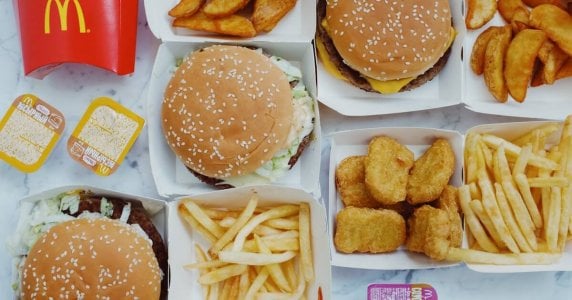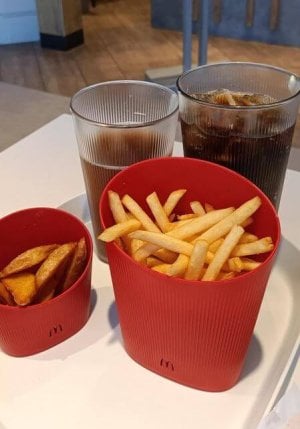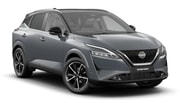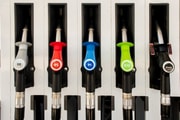Major changes spotted in McDonald's restaurants
- Replies 12
McDonald's has been steadily increasing their focus on sustainability in recent years, and it seems this commitment is being put into action with a major new change spotted in many of its restaurants.
Recently, photos of its new reusable containers have gone viral on social media, with the new packaging racking up thousands of reactions online.
Fast food giant McDonald’s stunned fans by quietly rolling out reusable containers in some of its restaurants worldwide.
Customers who have spotted the newest additions have shared photos of the new planet-friendly packaging and racking up thousands of reactions online.
In the U.S., some customers dining in will now be served their meals in reusable containers. After they eat, these containers will then be brought by the customers to a designated return point for them to be washed, sanitised, and readied for the next customer.
Macca’s packaging has always been made from paper and cardboard, but because this is usually contaminated with food scraps, it cannot be recycled without being cleaned first. What this does is that the majority of the restaurant’s consumer waste ends up in landfill, on the side of the road, or in our oceans.
McDonald’s effort comes as governments and investors are increasingly pressuring companies to restaurants to cut plastic waste, which has led fast food chains to consider reusing, and eventually recycling plastic utensils, cups, and other tableware.
‘Reusable packaging is one potential solution when applied correctly, but sustainable packaging is complicated,’ said John Blake, a Senior Director Analyst at Gartner Inc., which is supply chain practice.
He added: ‘Industries must test and pilot multiple paths in their sustainable packaging road map, and this should include reuse as well as reduction and recycling.’
The new packaging made headlines late last year after French President Emmanuel Macron re-shared a photo from a McDonald’s restaurant in France.
‘The anti-waste law is not only the end of plastic straws. Look around you: in France, we are making changes to our consumption patterns and reducing our waste. We are pushing to do it globally. Let's change the situation!’ Mr Macron said in his post.
During this time, it was reported that sustainable containers were a response to a new EU legislation that required all fast food packaging to be reusable or recyclable by the year 2030.
However, the fact that the environmentally-friendly containers are now showing up in restaurants in America suggests that the change could be a global shift.
McDonald’s released a statement regarding their efforts to build climate resilience.
‘Packaging is important in reducing food waste. Our packaging and waste strategies, as well as efforts to reduce plastics in Happy Meal toys, help keep communities clean, protect the planet for future generations and support long-term business resilience,’ they announced.
The fast food giant also shared that despite systemic challenges, such as recycling infrastructure limitations, the company remains committed to achieving a ‘more circular economy’ where they help keep materials in use rather than keep producing new ones.
‘We aim to help preserve and regenerate nature, support biodiversity and engage the communities and farmers closest to natural ecosystems to build resilience together,’ they added in their statement.
‘Approximately 82.7 per cent of our packaging materials and 96.8 per cent of our primary fibre packaging comes from recycled or certified sources.’
By the end of 2021, 35 per cent of their restaurants have offered guests the opportunity to recycle packaging.
McDonald’s also said they’re targeting 100 per cent of recycled or renewable packaging by the end of 2025.
According to Takeaway Packaging UK, a business-to-business provider of eco-friendly cardboard packaging, Macca’s restaurants all over the world collectively produce around three tonnes of waste every minute.
In Australia, McDonald’s sold $1.1 billion worth of food and drinks based on its 2020 annual report.
McDonald’s Australia has yet to confirm if the reusable containers will be available across the country.
 Are you looking forward to seeing this initiative in Australia? Let us know what you think in the comments below!
Are you looking forward to seeing this initiative in Australia? Let us know what you think in the comments below!
Recently, photos of its new reusable containers have gone viral on social media, with the new packaging racking up thousands of reactions online.
Fast food giant McDonald’s stunned fans by quietly rolling out reusable containers in some of its restaurants worldwide.
Customers who have spotted the newest additions have shared photos of the new planet-friendly packaging and racking up thousands of reactions online.
In the U.S., some customers dining in will now be served their meals in reusable containers. After they eat, these containers will then be brought by the customers to a designated return point for them to be washed, sanitised, and readied for the next customer.
Macca’s packaging has always been made from paper and cardboard, but because this is usually contaminated with food scraps, it cannot be recycled without being cleaned first. What this does is that the majority of the restaurant’s consumer waste ends up in landfill, on the side of the road, or in our oceans.
McDonald’s effort comes as governments and investors are increasingly pressuring companies to restaurants to cut plastic waste, which has led fast food chains to consider reusing, and eventually recycling plastic utensils, cups, and other tableware.
‘Reusable packaging is one potential solution when applied correctly, but sustainable packaging is complicated,’ said John Blake, a Senior Director Analyst at Gartner Inc., which is supply chain practice.
He added: ‘Industries must test and pilot multiple paths in their sustainable packaging road map, and this should include reuse as well as reduction and recycling.’
The new packaging made headlines late last year after French President Emmanuel Macron re-shared a photo from a McDonald’s restaurant in France.
‘The anti-waste law is not only the end of plastic straws. Look around you: in France, we are making changes to our consumption patterns and reducing our waste. We are pushing to do it globally. Let's change the situation!’ Mr Macron said in his post.
During this time, it was reported that sustainable containers were a response to a new EU legislation that required all fast food packaging to be reusable or recyclable by the year 2030.
However, the fact that the environmentally-friendly containers are now showing up in restaurants in America suggests that the change could be a global shift.
McDonald’s released a statement regarding their efforts to build climate resilience.
‘Packaging is important in reducing food waste. Our packaging and waste strategies, as well as efforts to reduce plastics in Happy Meal toys, help keep communities clean, protect the planet for future generations and support long-term business resilience,’ they announced.
The fast food giant also shared that despite systemic challenges, such as recycling infrastructure limitations, the company remains committed to achieving a ‘more circular economy’ where they help keep materials in use rather than keep producing new ones.
‘We aim to help preserve and regenerate nature, support biodiversity and engage the communities and farmers closest to natural ecosystems to build resilience together,’ they added in their statement.
‘Approximately 82.7 per cent of our packaging materials and 96.8 per cent of our primary fibre packaging comes from recycled or certified sources.’
By the end of 2021, 35 per cent of their restaurants have offered guests the opportunity to recycle packaging.
McDonald’s also said they’re targeting 100 per cent of recycled or renewable packaging by the end of 2025.
According to Takeaway Packaging UK, a business-to-business provider of eco-friendly cardboard packaging, Macca’s restaurants all over the world collectively produce around three tonnes of waste every minute.
In Australia, McDonald’s sold $1.1 billion worth of food and drinks based on its 2020 annual report.
McDonald’s Australia has yet to confirm if the reusable containers will be available across the country.
Key Takeaways
- McDonald's has introduced reusable containers in some of its restaurants, a move that aims to reduce waste.
- The new packaging follows EU legislation requiring all fast-food packaging to be reusable or recyclable by 2030, and McDonald's states its goal to reach 100 per cent recycled or renewable customer packaging by the end of 2025.
- McDonald's restaurants around the world produce around three tonnes of waste every minute.
- McDonald's Australia has been asked for information about when Australians can expect to see reusable containers.









